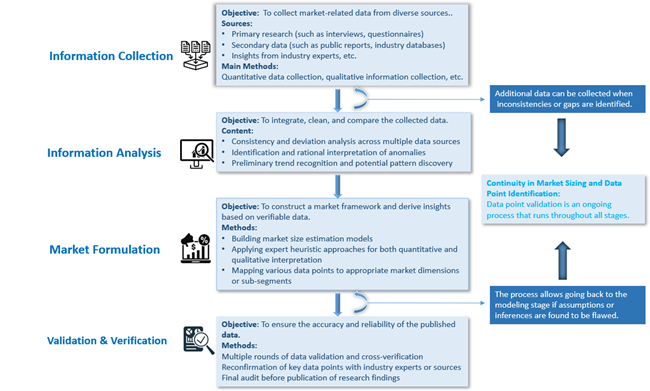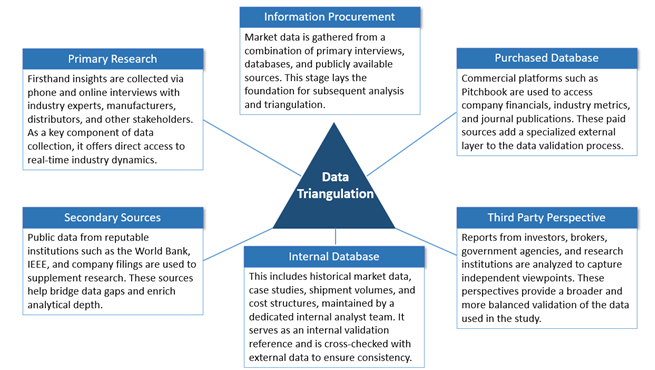Semiconductor Front-end Inspection and Metrology Equipment is used to
ensure the quality and reliability of microchips in the initial manufacturing
stage, with a focus on wafer manufacturing. The equipment includes various
tools and technologies for detecting defects on wafers, measuring key
dimensions, and analyzing material properties.
Front-end inspection is mainly used in wafer processing, and currently it
is mainly based on online monitoring of production lines in factories.
Front-end inspection equipment has two major functions: one is to ensure the
mass production yield of IC production lines, and the other is to
quantitatively monitor production equipment to provide a basis for equipment
acceptance and maintenance. Front-end inspection equipment can be classified
according to basic functions, technical means, and defect types.
From a process point of view, measurement/inspection equipment can be
divided into two major links: inspection and metrology. Inspection refers to
detecting whether there are heterogeneous conditions on the surface of the
wafer or in the circuit structure, such as particle contamination, surface
scratches, open short circuits, and other characteristic structural defects
that have adverse effects on chip process performance. Measurement refers to
the quantitative description of the structural dimensions and material
properties of the observed wafer circuit, such as the measurement of physical
parameters such as film thickness, critical dimensions, etching depth, and
surface morphology.
Market Overview
According to LookWhole Insight, the global Semiconductor Front-end Inspection and Metrology Equipment market is projected to reach USD 11.44 Billion in 2024. It is expected to grow to USD 23.16 Billion by 2033, registering a compound annual growth rate (CAGR) of 8.15% during the forecast period (2025–2033).
Key Development Trends
1. Multi-System Integration May Become a Development Trend
With
the continuous advancement of advanced process nodes, the complexity of IC
materials and structures is increasing. Defects to be detected are shifting
from surface-level to three-dimensional distributions, with increasingly
complex geometries and dimensions approaching atomic scales. As a result, it is
becoming increasingly difficult for single defect detection technologies to
meet requirements. Multi-system integration is likely to become the trend in
inspection technology development.
Pathway
1 – Traditional Optics:
Optical
inspection technologies based on bright-field and dark-field illumination have
been widely recognized by wafer fabs for their maturity, versatility, and
reliability. However, due to the limitations of Rayleigh scattering, it is
difficult to ensure high sensitivity at advanced nodes. Therefore,
signal-to-noise ratio analysis for different defect types is particularly
important.
Pathway
2 – Multi-Beam Electron Inspection:
Multi-beam
electron imaging offers higher lateral resolution. However, its inspection
speed still lags optical techniques by an order of magnitude. Research is
focused on achieving a balance among system complexity, overall cost, and
inspection efficiency.
Pathway
3 – Ultra-Short Wavelengths:
Techniques
such as ptychographic diffraction imaging based on extreme ultraviolet (EUV)
and hard X-ray wavelengths show promise for enabling 3D imaging of surface and
subsurface defects on wafers. However, the lack of tabletop EUV and X-ray
sources with high brightness, coherence, and stability remains a key
bottleneck.
Pathway
4 – Structured Light Fields:
This
approach aims to fully exploit the multidimensional intrinsic characteristics
of light as a 3D electromagnetic field—beyond amplitude to include frequency,
phase, polarization state, and orbital angular momentum—in order to maximize
defect detection sensitivity.
2.
Advanced Nodes Drive Increased Equipment Investment Demand
The
value of inspection and metrology equipment per wafer is expected to multiply
with advanced process development. AI chips demand higher performance, lower
power consumption, and optimized cost, making advanced nodes particularly
advantageous. As vehicle intelligence evolves, traditional chips like MCUs can
no longer meet the market's needs. The increasing functionality of automotive
chips is expected to accelerate the adoption of advanced manufacturing
processes.
Currently,
mainstream semiconductor nodes are evolving from 28nm and 14nm toward 10nm and
7nm, with some leading-edge manufacturers achieving volume production at 5nm
and initiating R&D on 3nm. New technologies such as 3D FinFET transistors
and 3D NAND are also becoming mainstream. These advances lead to an increase in
process steps and microstructural complexity. To maximize wafer yield, future
inspection/metrology tools will need improvements in sensitivity, accuracy,
stability, and throughput.
3. Electron Beam Inspection Supports Advanced Node Development
Electron beam inspection can significantly improve resolution. Accelerated electrons have wavelengths up to one ten-thousandth that of visible light, allowing electron beams to drastically enhance instrument resolution when used as illumination sources.
Electron microscopes, which use electron beams and electromagnetic lenses to form images and integrate mechanical, electronic, and high-vacuum technologies, include scanning electron microscopes (SEM), transmission electron microscopes (TEM), scanning transmission electron microscopes (STEM), atomic force microscopes (AFM), analytical electron microscopes, and ultra-high-voltage electron microscopes.
Compared to optical inspection, electron beam inspection is slower and more expensive but provides higher precision. According to MMR, in 2022, applications below 1nm accounted for over half of the global electron beam inspection market. As IC process nodes shrink, defect sizes decrease, defect densities increase, and the risk of missed detections rises. Electron beam inspection offers significant resolution advantages and unique capabilities in identifying electrical defects.
From 2025 to 2033, the global electron beam inspection market is expected to grow rapidly, with applications above 10nm projected to become the main market for this technology by 2033.
Global Semiconductor Front-end Inspection and Metrology Equipment Market: Competitive Landscape
The global semiconductor mass testing equipment market has a high degree of concentration. In 2020, the industry's CR5 exceeded 80%. The top five equipment manufacturers are all from the United States and Japan, mainly including KLA, Applied Materials, Hitachi, etc., among which KLA has a market share of as high as 50%.
KLA remains the market leader with a broad portfolio of optical inspection, electron beam systems and advanced process control software. Its strengths lie in its deep customer relationships with foundries such as TSMC, Samsung and Intel, and its tools are well integrated in multiple process steps. KLA has undergone many mergers and acquisitions. KLA Instruments and Tencor Instruments were founded in 1976 and 1977, respectively, and merged in 1997 to form KLA-Tencor. Since its establishment, KLA has successively acquired many companies, and its current product line covers the full range of quality control equipment. Compared with international semiconductor equipment giants such as Applied Materials, ASML, and Hitachi, KLA has the most complete range of front-end inspection products, demonstrating its industry dominance. By product, KLA's main products include wafer inspection (system only), chip inspection (system only), semiconductor process (system only), PCB/display/device inspection (system only), services and others (KLA Pro). By region, KLA's main revenue comes from mainland China, Taiwan, China and South Korea.
Emerging companies and startups are also shaping the industry landscape. Companies such as PDF Solutions and Nanotronics are innovating in AI-based defect analysis, providing fabs with tools to predict, classify and prevent yield loss throughout the production line. Nearfield Instruments, a startup spun out of the Netherlands Institute for Applied Scientific Research (TNO), is pioneering scanning probe microscopy technology to provide sub-surface imaging at resolutions beyond what traditional optical or electron beam tools can achieve. Meanwhile, local Chinese companies such as Camtek Ltd. are benefiting from national industrial policies aimed at reducing reliance on U.S. and Japanese suppliers, even though they currently lag in high-end tool capabilities.
Report Framework and Key Highlights:
Market Dynamics: Identification of major market drivers, restraints, opportunities, and challenges.
Trend Analysis: Examination of ongoing and emerging trends impacting the market.
Competitive Landscape: Detailed profiles and market positioning of major players, including market share, operational status, product offerings, and strategic developments.
Strategic Analysis Tools: SWOT Analysis, Porter’s Five Forces Analysis, PEST Analysis, Value Chain Analysis
Market Segmentation: By type, application, region, and end-user industry.
Forecasting and Growth Projections: In-depth revenue forecasts and CAGR analysis through 2033.
This report equips readers with critical insights to navigate competitive dynamics and develop effective strategies. Whether assessing a new market entry or refining existing strategies, the report serves as a valuable tool for:
Industry players
Investors
Researchers
Consultants
Business strategists
And all stakeholders with an interest or investment in the Semiconductor Front-end Inspection and Metrology Equipment market.
Global Semiconductor Front-end Inspection and Metrology Equipment Market: Segmentation Analysis and Strategic Insights
This section of the report provides an in-depth segmentation analysis of the global Semiconductor Front-end Inspection and Metrology Equipment market. The market is segmented based on region (country), manufacturer, product type, and application. Segmentation enables a more precise understanding of market dynamics and facilitates targeted strategies across product development, marketing, and sales.
By breaking the market into meaningful subsets, stakeholders can better tailor their offerings to the specific needs of each segment—enhancing competitiveness and improving return on investment.
Global Semiconductor Front-end Inspection and Metrology Equipment Market: Market Segmentation Analysis
The research report includes specific segments by region (country), manufacturers, Type, and Application. Market segmentation creates subsets of a market based on product type, end-user or application, Geographic, and other factors. By understanding the market segments, the decision-maker can leverage this targeting in the product, sales, and marketing strategies. Market segments can power your product development cycles by informing how you create product offerings for different segments.
|
ATTRIBUTE |
Details |
|
|
Time Coverage |
Historical Year: 2020– 2024 Base Year: 2024 Estimated Year: 2025 Forecast Year: 2025 - 2033 |
|
|
Market Segmentation |
||
|
By Type |
Probe Optical Electron beam X-ray Others |
|
|
By Application |
Photolithography Etching Thin film deposition Heat treatment Others |
|
|
By Company |
KLA Corporation Applied Materials, Inc. HITACHI ASML Holding NV ONTO Nova Lasertec Park Systems Camtek Ltd. Skyverse Technology Shanghai Precision Measurement Shanghai Ruili DongFang JingYuan Electron Secote Precision Electronic Chengfeng Technology TZTEK Technology Lasertec Nearfield Instruments |
|
|
By Region |
North
America |
|
Report Framework and Chapter Summary
Chapter 1: Report Scope and Market Definition
This chapter outlines the statistical boundaries and scope of the report. It defines the segmentation standards used throughout the study, including criteria for dividing the market by region, product type, application, and other relevant dimensions. It establishes the foundational definitions and classifications that guide the rest of the analysis.
Chapter 2: Executive Summary
This chapter presents a concise summary of the market’s current status and future outlook across different segments—by geography, product type, and application. It includes key metrics such as market size, growth trends, and development potential for each segment. The chapter offers a high-level overview of the Semiconductor Front-end Inspection and Metrology Equipment Market, highlighting its evolution over the short, medium, and long term.
Chapter 3: Market Dynamics and Policy Environment
This chapter explores the latest developments in the market, identifying key growth drivers, restraints, challenges, and risks faced by industry participants. It also includes an analysis of the policy and regulatory landscape affecting the market, providing insight into how external factors may shape future performance.
Chapter 4: Competitive Landscape
This chapter provides a detailed assessment of the market's competitive environment. It covers market share, production capacity, output, pricing trends, and strategic developments such as mergers, acquisitions, and expansion plans of leading players. This analysis offers a comprehensive view of the positioning and performance of top competitors.
Chapters 5–10: Regional Market Analysis
These chapters offer in-depth, quantitative evaluations of market size and growth potential across major regions and countries. Each chapter assesses regional consumption patterns, market dynamics, development prospects, and available capacity. The analysis helps readers understand geographical differences and opportunities in global markets.
Chapter 11: Market Segmentation by Product Type
This chapter examines the market based on product type, analyzing the size, growth trends, and potential of each segment. It helps stakeholders identify underexplored or high-potential product categories—often referred to as “blue ocean” opportunities.
Chapter 12: Market Segmentation by Application
This chapter analyzes the market based on application fields, providing insights into the scale and future development of each application segment. It supports readers in identifying high-growth areas across downstream markets.
Chapter 13: Company Profiles
This chapter presents comprehensive profiles of leading companies operating in the market. For each company, it details sales revenue, volume, pricing, gross profit margin, market share, product offerings, and recent strategic developments. This section offers valuable insight into corporate performance and strategy.
Chapter 14: Industry Chain and Value Chain Analysis
This chapter explores the full industry chain, from upstream raw material suppliers to downstream application sectors. It includes a value chain analysis that highlights the interconnections and dependencies across various parts of the ecosystem.
Chapter 15: Key Findings and Conclusions
The final chapter summarizes the main takeaways from the report, presenting the core conclusions, strategic recommendations, and implications for stakeholders. It encapsulates the insights drawn from all previous chapters.






